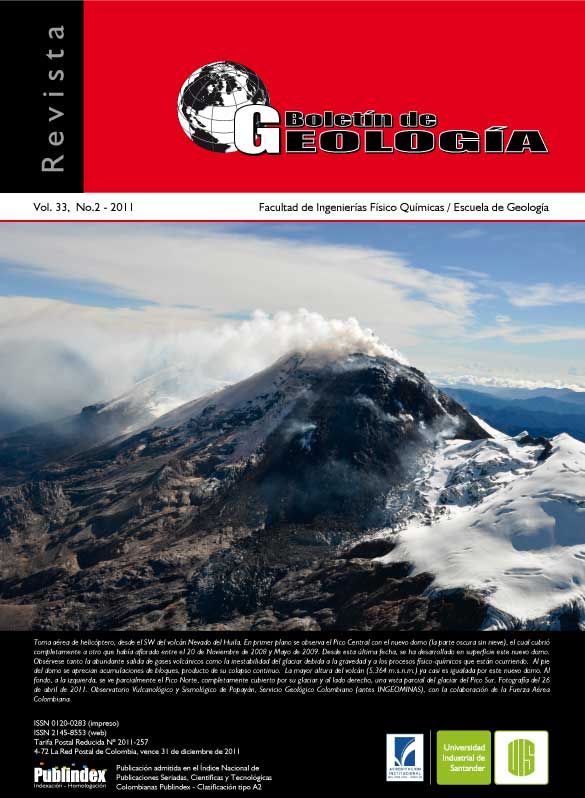HIDROCARBON GEOCHEMISTRY OF THE BAJA GUAJIRA SUB-BASIN,COLOMBIA
Published 2011-12-06
How to Cite
Abstract
This paper proposes two petroleum systems in the Baja Guajira Sub-basin: 1) The Upper Cretaceous Formation-Castilletes Formation system and 2) The Siamana Formation- Macarao Formation-Castilletes Formation system. Geochemical models in two dimensions, calibrated with thermal maturity data, indicate that hydrocarbons have been originated at the base of the stratigraphic sequence and have migrated upward. The critical factor indetermining the formation of the Chuchupa and Ballena gas field was the presence of sealing beds in the top ofthe Castilletes Formation. Well information from the Baja Guajira Sub-Basin reveals a relatively absence of low permeable strata explaining the scatter occurrence of gas field in the Guajira Sub-Basin. The geochemical information along with the geochemical models allow to locate the best prospective area forhydrocarbons, which is located toward the norwest of the Baja Guajira Sub-basin in the offshore region, where it is expected the presence of several hydrocarbon kitchens.
Keywords: Geochemistry, Baja Guajira, hydrocarbon, petroleum system, Tmax, %Ro.
Downloads
References
Almarza, R.1997. Campos petrolíferos de Venezuela, Golfo de Venezuela, PDVSA-Intervep.
Barrero, D., Aguiar, Y., Robledo, A., Hernández, C., Martínez, J., Rojas, O., Valencia, E., Álvarez, M. and Ojeda, Y.2005- 2006. High potential lightly explored basin, Onshore Guajira Basin. ANH, Bogotá
Barrero, D., Pardo, A., Vargas, C. and Martínez, J. 2007. Colombian sedimentary basins: Nomenclature, boundaries and petroleum geology, a new proposal. ANH, Bogotá.
García-González, M., Cruz-Guevara, L. E., Mier-Umaña, R., et. al. 2009. Evolución térmica de la Subcuenca de la Baja Guajira. Informe interno N° 56 de 2008 UIS-ANH. En: www.anh.gov.co
García-González, M., Cruz-Guevara, L. E., Mier-Umaña, R., et. al. 2010. Evolución térmica de la Subcuenca de la Baja Guajira. Boletín de Geología, Universidad Industrial de Santander, 32(2): 55-71
Gómez, J., Nivia, A., Montes, N., Jiménez, D., Sepúlveda, M., Gaona, T., Osorio, J., Diederix, H., Mora, M. y Velásquez, M. 2007 a. Atlas geológico de Colombia, plancha 5-01, Escala 1: 500.000, INGEOMINAS
Gómez, J., Nivia, A., Montes, N., Jiménez, D., Sepúlveda, M., Gaona, T., Osorio, J., Diederix, H., Mora, M. y Velásquez, M. 2007 b. Atlas geológico de Colombia, plancha 5-02, Escala 1: 500.000, INGEOMINAS
Katz., B. and Williams, K. 2003. Biogenic gas potential offshore Guajira Peninsula, Colombia. In: Bartolini, C. Buffer, R. T. and Blickwede, J. eds. The Circum-Gulf of Mexico and the Caribbean:Hydrocarbon habitats, Basin formation, and plate tectonics. AAPG Memoir 79: 961-968.
